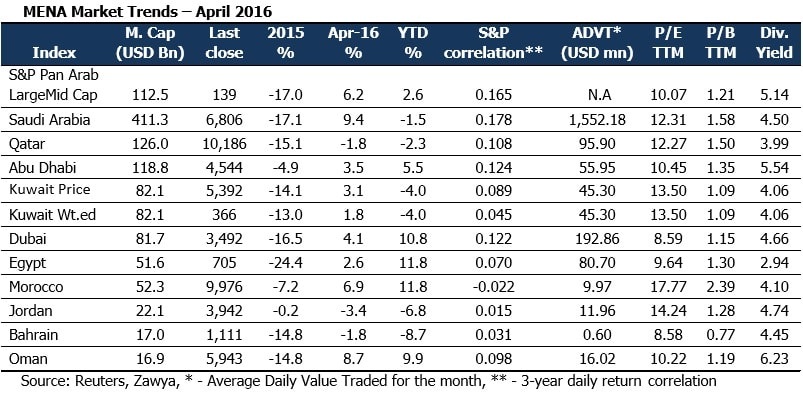
MENA markets liquidity had a negative month, with volumes decreasing by 32% and value traded falling by 7%. Morocco and Bahrain witnessed increases in both volume and value traded, whereas the rest of the markets recorded declines in both. Volume and value traded in Morocco increased by 32% and 44%, respectively, despite which the index declined by 2.2% in May.
Most Blue Chips ended the month of April in red, barring Emirates NBD (UAE) and Saudi Electricity (SEC, KSA). Emirates NBD entered into a co-location agreement with Du that will help optimize operational expenses, and provide direct access to vital data center ecosystem. The Saudi government is reviewing plans to break up SEC into four divisions, as part of a drive to privatize the utility. NBAD (UAE, -12.2%) and Ooredoo (Qatar, -10.6%) stocks had a poor streak in May. Financial institutions in Abu Dhabi are witnessing tightening liquidity conditions due to weaker energy revenues, prompting NBAD to look beyond domestic operations for revenue. Ooredoo posted a Q1 revenue of USD 2.16bn, down 2% from 1Q15, as revenues from the voice segment contracted. Arabtec Holding (UAE) declared a loss of USD 12.6mn for the first quarter of the year, as the company struggles with a difficult environment, due to slowdown in Gulf economies and governments restraining spending because of low oil prices. Ongoing expansion of projects and comprehensive development plans on facilities and assets have helped Ezdan Holding Group (Qatar) record a USD 161mn first-quarter net profit, a 12% growth compared to the USD 143.5mn posted in 1Q15.
Saudi Arabia Market Reforms
Saudi Arabia announced a string of reforms to its stock market in a bid to attract billions of dollars of foreign investment, and to facilitate the smooth sales of state assets, as the kingdom grapples with deficit caused by low oil prices. In Jun’15, the Saudi CMA took a cautious approach to market reforms, however, in May’16, more reforms were announced to aggressively court foreign investors.
In May 2016, the kingdom announced a cut to the amount of assets foreigners must have under management to invest directly in the nation’s stocks to USD 1bn from USD 5bn in Jun’15. The CMA will also now accept investments from sovereign wealth funds and university endowments. The exchange will also amend its settlement cycle to T+2 (from T+0) for share trading, bringing it in line with European markets. Each of the foreign institutional investors (FIIs) will be allowed to own directly a stake of just under 10 per cent of a single listed company, up from a previous ceiling of 5 per cent. Other restrictions were scrapped, including a ceiling of 10 per cent on combined ownership by foreign institutions of the market's entire capitalization. All foreign investors combined will still be limited to owning 49 percent of any single firm.
Saudi CMA has also approved the introduction of securities lending and covered short selling to the stock market, which would give investors more options to hedge their purchases against market downturns. The changes will be effective before the end of the first half of 2017.
Oil Market Review
Brent crude crossed the USD 50 per barrel in the month of May, the first time since Nov’15, before climbing down marginally, and closing the month at USD 49.69 per barrel, up 3.2 per cent from last month’s close. Supply disruptions in Nigeria, Canada and Venezuela, and stronger overall demand has led to rise in price of the oil this month. Investors brushed aside concerns regarding higher Middle East output, as fight for market share between Saudi Arabia and Iran is on the cards.
Stay Tuned To Marmore MENA Insights!
Never miss a patch or an update with Marmore's Newsletter. Subscribe now!
Related Article
The uptick in MENA Eurobond issuances – A sign of things to come?
MENA debt issuances have touched record highs in Q1 2025. Will the uptick continue in subsequent quarters?
Read MoreKuwait’s Approval of Public Debt Law: Re-emerging on Investors’ Radar
Kuwait has passed the long-awaited debt law in March 2025. The blog explores the importance of the law, the expected benefits and outlook for the countrys return to debt markets.
Read MoreThe Dynamic Rise of Fintech in the GCC
The convergence of technology and finance is reshaping the GCC Financial Ecosystem. The blog explores key players, regulatory framework and market dynamics of Fintech in the GCC region.
Read More




